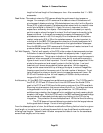
Section 4 - Camera Hardware
Page 27
Camera
A/D
Resolution
Temperature
Regulation
Electromechanical
Shutter/Shutter
Wheel/Vane
Electronic
Shutter
ST-5C 16 bits Closed Loop Shutter Wheel 0.01 second
ST-237 12 bits Closed Loop Shutter Wheel 0.01 second
STV 10+2 bits Closed Loop Shutter Wheel 0.001 second
ST-6 16 bits Closed Loop Vane 0.01 second
ST-7E/8E/9E 16 bits Closed Loop Shutter None
Table 4.2 - System Features
How these features affect the average user are discussed in the paragraphs below:
A/D Resolution - This is a rough indication of the camera's dynamic range. Higher precision
A/D Converters are able to more finely resolve differences in light levels, or for
larger CCDs with greater full well capacities, they are able to handle larger total
charges with the same resolution.
Temperature Regulation - In an open loop system like the original ST-4 the CCD cooling is
either turned on or turned off. While this provides for adequate cooling of the
CCD, the CCD's temperature is not regulated which makes it important to take
dark frames in close proximity to the associated light frame. Closed loop
systems regulate the CCD's temperature to an accuracy of ±0.1° C making dark
frames useful over longer periods.
Electromechanical Vane - Having the vane in the ST-6 means the host software can effectively
"cover the telescope" and take dark frames remotely, without the user having to
get up and physically cover the telescope.
Electromechanical Shutter - Having the shutter in the ST-7E/8E/9E gives streak-free readout
and allows taking dark frames without having to cover the telescope. While the
minimum exposure is 0.11 seconds, repeatability and area uniformity are
excellent with SBIG's unique unidirectional shutter.
Shutter Wheel - The Shutter Wheel, used in conjunction with the camera's Electronic shutter,
allows you to cover the CCD for taking dark frames and in the case of the
ST-5C/237 allows replacement with a mini internal color filter wheel.
Electronic Shutter - Having an electronic shutter involves having a CCD with a frame transfer
region. These CCDs actually have an array that has twice the number of rows
advertised, where the bottom half is open to the light (referred to as the Image
Area), and the top half is covered with a metalization layer (referred to as the
Storage Area). In frame transfer CCDs at the end of the exposure, the pixel data
from the Image Area is transferred into the Storage Area very rapidly where it
can be read out with a minimum of streaking.
In addition to the system level differences between the various cameras, Table 4.3 below
quantifies the differences between different CCDs used in the cameras:


















